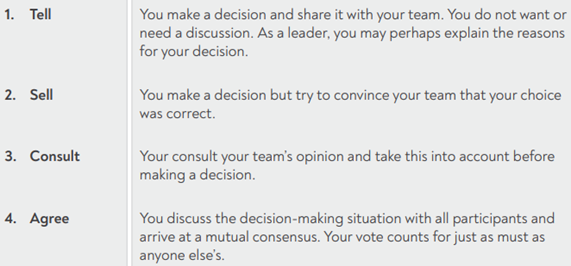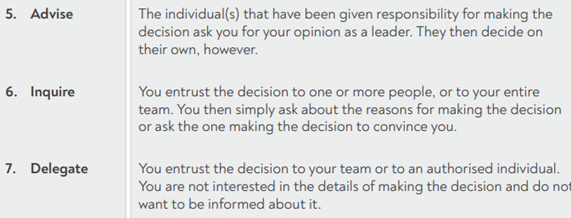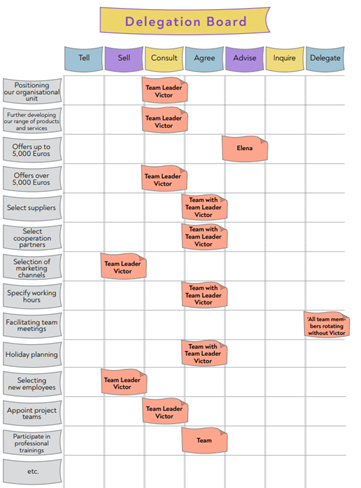- Introduction
- Section 1: Assignment of tasks - What do people with epilepsy need?
- Section 2: Assignment of tasks – sensitisation to needs within the team
- Section 3: Long-term goal: self-organising tasks
- Concluding remarks
- Quiz
In section 1 and 2 we have looked at how to assign tasks for people with epilepsy and how important it is to understand the needs of the entire team to create a respectful and pleasant work atmosphere. In the long term, the goal for organisations may be for employees to organise tasks themselves. In doing so, employees can align with their individual needs and preferences. This means that an organisation is evolving towards a more self organised way of work.
Every organization should embrace the idea of self-organization. This approach allows decision-making responsibilities to be shared across multiple individuals.. A holistic approach that understands inclusive leadership as both the development of people and organisations is important. Leaders can become more effective if they focus on decentralisation, shared responsibility, and collaborative decision-making.
How can an organisation evolve into becoming more self-organised? How can team members, both people with epilepsy and the rest of the team, self-organise and assign tasks independently and thereby be successful? This requires encouraging employees to take ownership and act responsibly. The Erasmus+ project INCLUDE can provide valuable support in this regard by offering a handbook with 27 tools to help organisations self-organise in the age of digitalisation.
One effective tool is the “Delegation Board.” It supports individuals with epilepsy, along with other team members, in taking responsibility and self-organizing their tasks. To foster greater team responsibility, delegation should involve clearly entrusting decision-making and goal attainment. This approach allows team members to exercise their judgment within set boundaries and learn from their mistakes. Unlike traditional top-down management, where tasks and goals are handed over for later supervision, the Delegation Board approach means handing over responsibility for the final result and encouraging independent action. Achieving this goal involves collaboratively determining the levels of delegation with your team.
The first decision revolves around the extent of assumed responsibility. Delegation doesn’t necessitate an all-or-nothing approach, wherein you either oversee every aspect of a task or that you delegate entirely. Instead, you can opt for a more nuanced approach. Select a delegation level that aligns with the individuals and the specific situation to enhance your team’s engagement, encourage their development, and unleash their potential – benefitting both you and your team members. The delegation board provides a framework for determining the appropriate delegation level, allowing you to consider factors like the leader’s competence and maturity, the team’s capabilities, task complexity, and the business environment. With the delegation board the assignment of tasks can be visualised in a way that everyone can understand. This is done by differentiating between seven levels of delegation, from direct instructions through to the highest level of handing over control, where a leader is no longer involved at all. The nearer a team gets to this seventh level, the further they are on their journey towards becoming a truly self-organised team.
The seven levels of delegation: Between complete control and full trust, there are intermediate steps. The Delegation Board outlines seven levels of delegation, helping leaders who struggle with relinquishing control to structure the process of ‘letting go.’ At the same time, team members who previously had little to no responsibility are encouraged to take on more for the benefit of the entire team.


Figure: INCLUDE – Handbook, p. 376f
In levels 1 to 3 the responsibility for making the decision lies with the leader. In level 4 everyone is equally involved in the decision. In levels 5 to 7 the team or individual team members assume the decision-making responsibility. On the delegation board you can easily recognise visually the extent to which the responsibility for the decision moves away from the leader on the right to the team or the team members on the left.
Example for a filled in Delegation board:

Figure: INCLUDE – Handbook, p. 375
Task: Develop a delegation board for your team
Start by answering the following question: why do you want to use the delegation board? There are various appropriate ways of putting it to use. Several of the following aspects usually come together.
- You want to clearly define the relationship between you and your team members that you are delegating tasks to.
- You want to determine the responsibilities within your team from scratch.
- You want to define the boundaries of individual team members’ responsibility.
- You are not sure of the extent to which your team or individual team members are able and willing to take on real responsibility. You therefore need a flexible and easily adjustable tool.
- You would like to lighten your own workload and / or that of some of your team members.
Create a list of decisions and tasks you want to delegate, using the Delegation Board (left-hand column) with your team’s input. Remember, as the leader, you decide which decisions and tasks to regulate with the board. Alternatively, you can choose these decisions and tasks together with your team, which works well for teams that are already experienced in self-management..
Keep a written record of what exactly should be decided for each individual decision or task. This makes it clear for all participants what is implied in the brief description in the left-hand column of your delegation board. These explanations also make it easier to integrate new team members. It is particularly important to clearly define what a task entails in organisations where most decisions have been made by the leader. This is the only way to ensure that your team members have a thorough overview of the consequences of each of the decisions. This will equip your team members to play a competent role in discussing how responsibility should be redistributed. If you create the list of decisions and tasks together with your team, then you can use the discussion about the various positions to ensure that everyone understands the specific tasks in the same way. In this instance the results should also be recorded in writing so that everyone can understand them.
Finish by creating a list with the names of everyone who can or should take on responsibility. This list will include the names of all team members, you as a leader, individual clearly defined roles within the team, or the entire team (with or without the leader).
Organise a team meeting and ensure that all team members can attend. The integration of new team members or the start of a new project are good opportunities to start working with the Delegation Board.. If you are already convinced that the Delegation Board is a useful tool then you shouldn’t wait for one of these opportunities, however.
Explain to everyone in the team what the delegation board is and why you have decided to suggest that the team should work with this tool. Focus on showing the advantages that using the delegation board would have for your team, for each individual team member, and for you as a leader.
Explain the seven levels of delegation and how they are different from each other. Think about some examples that are easy to understand and have a link to your daily work in the team. You could also use the resources that we recommend below, including an explanatory video.
Together with your team, you can determine an appropriate level of delegation for each decision or task in the left-hand column of the board. It works best if you prepare a flipchart with post-it notes for this. If you are conducting the meeting online, then there are tools such as Miro (see resources below) that work well for this. The decision-making process will then go as follows:
- All participants will state which level of delegation they think is appropriate.
- You will discuss the arguments that speak for or against the suggested level of delegation and try to reach an agreement.
- If you cannot reach a consensus, then you as a leader have the decisive vote.
The results should be depicted in a way that they can be easily accessed both physically and virtually by all participants.
For further information and tips on the day-to-day support in using the delegation board see the INCLUDE handbook, p. 373ff.
